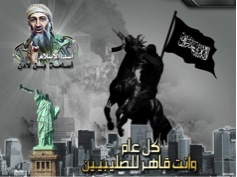Group Name
AQ
Group Type
Jihadist Group
Dominant Colors
Gray, Black
Secondary Colors
Green, Yellow
Language
Arabic
Isolated Phrases / Mottoes / Slogans
1) shahada 2) kull `am wa-anta qahir lil-salibiyyin 3) asad al-islam usama b. ladin
Image Number
0382
Groups Region of Operation
Global
Body Parts
Face / Bust
Air
Clouds / Fog, Sky
Fire
Light Rays / Light, Burning Object, Smoke
FIre Analysis
Twin Towers
Geopolitical Symbols
Non-country Flag, Slogan
Geopolitical Analysis
Black flag
People
Group Leader / Influential figure, Operational Leader, Operative / Warrior (=mujahid), Man / Men
People Analysis
Usama b. Ladin (AQC)
Religious Textual References
Shahada, Use of Calligraphy
Religious Textual References Analysis
La ila illa Allah, Muhammad rasul Allah
Religious Symbols
Black / White / Green Banners
Religious Symbols Analysis
Black banner with text of shahada.
Fauna
Horse
Topography
Man-made Structure / Landmark
Topography Analysis
Twin Towers and smoking NYC sky line
Visual Themes
The horse and rider motif is common in Islamic imagery and jihadi visual propaganda.The importance of the horse in both pre-Islamic Arabia and Islamic culture is evidenced by pre-Islamic poetry, hadiths (prophetic traditions or reports) and other genres of literature ascribing horses with the positive qualities of chivalry and bravery in battle. For example, the beginning of the Qur’anic sura 100 talks about “running horses” that appear as galloping through the world toward the final goal, namely, Judgment Day. Horses are also symbolic of the first generation of Muslims and that generation’s successful military campaigns, and thus are often employed to evoke specific Salafi religious sentiments with regard to the military victories of Muhammad and his companions. The rider emphasizes the element of human agency in jihad, and is a way to enhance the traditional symbol of a horse and flesh out notions of aggression and the call to jihad. Overall, the horse and rider motif places current jihadi activities within the same unfolding dialectic as the jihad of early Islam.

 Skip to content
Skip to content
